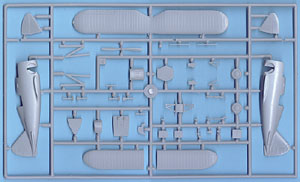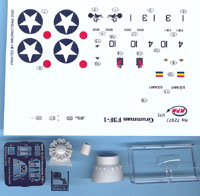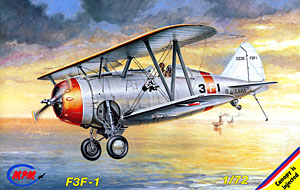MPM’s 1/72 Grumman F3F-1 By Norm Filer | | History We’re all probably familiar with the Grumman series of Navy fighters; The “Cats” and Avengers filled the decks of the U.S. Navy’s Carriers during WWII. We still see the Tomcats on Navy carrier decks today. The Grumman Aircraft Co. was formed just after the now infamous stock market crash of Dec. 1929. In hindsight, this was not the best of times to be off on a new venture. The apparent reason for the new start was the purchase of Loening Aeronautical Engineering Co. by Keystone Aircraft Corp. Leroy Grumman and several of his Loening associates apparently did not wish to make the move from Long Island, New York to Bristol, Pennsylvania. They set up shop in a small garage and their first product was intended to be a series of amphibious floats using Loening’s landing gear design. They also hoped for some float repair work from Loening. The former employees had an excellent working relationship with Grover Loening, perhaps due to the fact that his brother had joined Grumman in the exit from the now defunct Loening Company. When that work did not materialize, they stayed financially alive by building 25 truck trailer bodies. The small company made several proposals to the Navy, but the first acceptance came in April 1931 when the Navy bought the FF-1. The FF-1 was a two-place navy fighter with the portly lines that were to quickly become very familiar on a succession of Grumman airplanes. It is worth noting that from that point on Grumman had very few proposals that did not turn into gold. The first failure was the then rather radical XF5F Skyrocket, then much later the equally radical XF10F. One would expect the long string of successful designs and sales to ensure the future. Apparently that did not work. Today the Grumman Aircraft Corp. is a part of Northrop Corporation of California.  The Kit The Kit
First, and not unexpected, this thing is dinky! The top wing spans about 5.3 inches and the fuselage is about 4 inches long. There are 32 injection-molded parts, 4 Grey resin parts, a small etched-brass fret and one fabulous canopy. I always have been somewhat skeptical that these “limited run” firms could provide the delicateness I want with these small-scale biplanes. This little gem goes a very long way toward proving that wrong. I am not sure that this kit would be significantly different or better if the box said Hasegawa or Revell. The panel lines are engraved on the fuselage so finely that it is necessary to hold it just right in the light to see them. The rib detailing on the wings is, in my opinion, just about right. This wing rib thing is always a difficult call. Some like them to be very noticeable and others would prefer that they almost not be visible at all. A coat of yellow paint will make these ribs look very realistic, and the ribs on the bottom of both wings are correctly somewhat flatter than the top surfaces. One of the past drawbacks of these limited run kits has been the lack of alignment help and overall general thickness of parts. The alignment issue is still here. There are no pins, tabs or holes to help with construction. There are very lightly engraved panel lines on the center of the fuselage to attach the top wing. The only help you get with the N struts is small squares where they go into the top and bottom wing. It would probably be best to attach the top wing after most all the other construction is done and glue it on with just the N struts. Installing the center section struts then would be a very delicate tweezers project. We won’t even talk about rigging this little jewel! That will be a challenge for the “real” modelers out there. But it is a biplane, they are rigged, and this one should be too.  The above-mentioned overall thickness of parts is not an issue with this kit. The measured fuselage wall thickness is just under .048 inches. As a comparison, the new 1/72 Tamiya Mustang has a wall thickness of .035. There is some flash noticeable where the molds came together. This is evident in locations like the leading and trailing edge of the one-piece wings or around the circumference of the wheels. I would not call this a flaw in any way. A swipe with light sandpaper will make it disappear quickly. The somewhat larger than high pressure kits attachment points are still there and will require a bit of care to cut off and finish, but again, they are a small thing. The above-mentioned overall thickness of parts is not an issue with this kit. The measured fuselage wall thickness is just under .048 inches. As a comparison, the new 1/72 Tamiya Mustang has a wall thickness of .035. There is some flash noticeable where the molds came together. This is evident in locations like the leading and trailing edge of the one-piece wings or around the circumference of the wheels. I would not call this a flaw in any way. A swipe with light sandpaper will make it disappear quickly. The somewhat larger than high pressure kits attachment points are still there and will require a bit of care to cut off and finish, but again, they are a small thing.
The dinky stuff like gear struts, prop, N struts, telescopic sight and tail wheel and strut are very delicately done. In fact they are going to be rug food if they are ever dropped. Also included is a very small brass fret with the usual positive photo insert of the instrument panel to go behind the brass instrument panel. The brass set also includes a few other rug food candidates. There are three resin parts to this kit: the flat on the back, half-cylinder engine, a spacer to mount the engine away from the firewall, and a very thin walled but beautiful bump cowling. The cowling is poured from the front, with the engine opening still closed off by the resin plug. My first reaction to this was somewhat skeptical, but after a little careful work I think it will be just fine. My guess (hope?) is that this separate resin cowling was done with the intent of using the same parts with a new cowling casting for the later F3F-2 and -3 versions. One of several gems in this kit is the canopy. This is of course a small airplane and the canopy is very small! No separate windscreen and sliding canopy here, just one very (VERY!) clear and thin injection molded part. I suspect the wall thickness of this canopy is thinner than just about any other canopy I have ever seen. It is BEAUTIFUL!! Poor canopies are a part of limited run kits that MPM apparently has fixed. The decals are as usual Propagteam and up to the standards of the rest of the kit. Markings for two birds, a Green tailed (USS Ranger) VF-4 Red Rippers, and a Blue tailed (USS Saratoga) VF-3 Felix the Cat. A couple of nice little things on the decals is the inclusion of the prop bands and a lot of white pin striping to use on the fuselage, wing and cowling markings that will need to be painted. Conclusion If you have read this far, you may have decided I like this little jewel. My primary interest is 1/72 U.S. Military aircraft. I have been out of the “Yellow Wing” era for a long time due mostly to a lack of decent kits. This one and the already announced Curtiss Sparrowhawk may just get me back into the neat little biplanes again. Tune in to a future issue to see if these old eyes and shaky hands are up to the building/rigging of something this small and delicate. | 









    |
